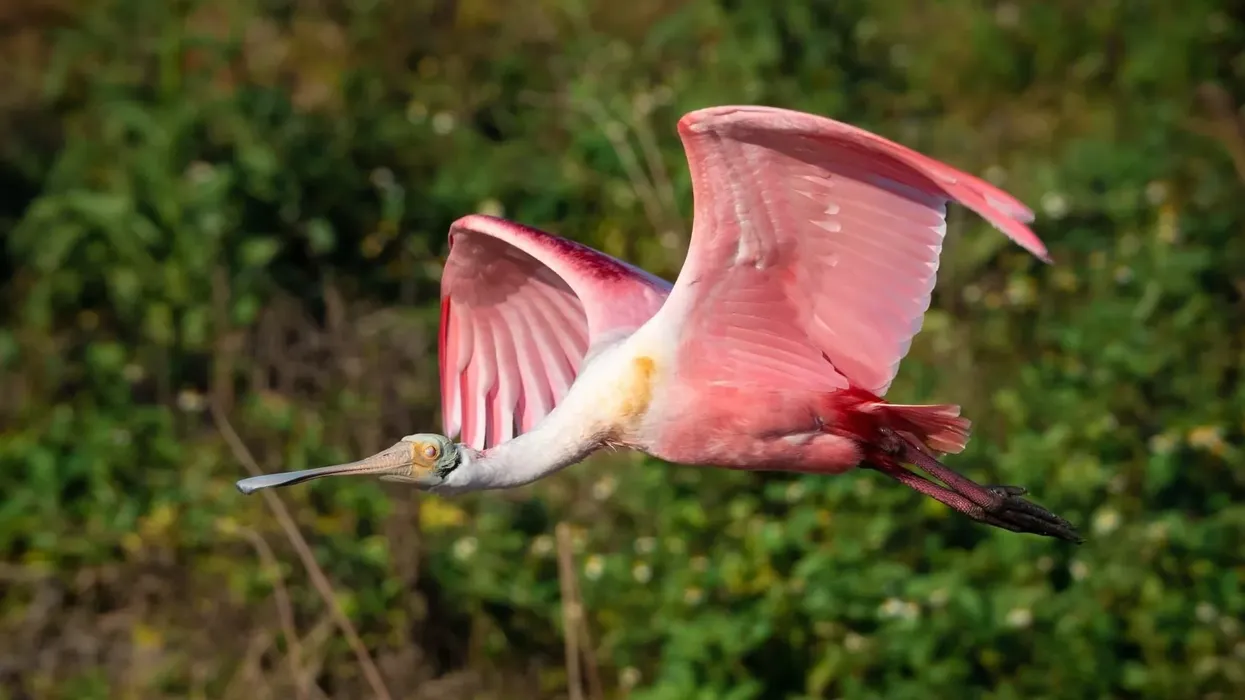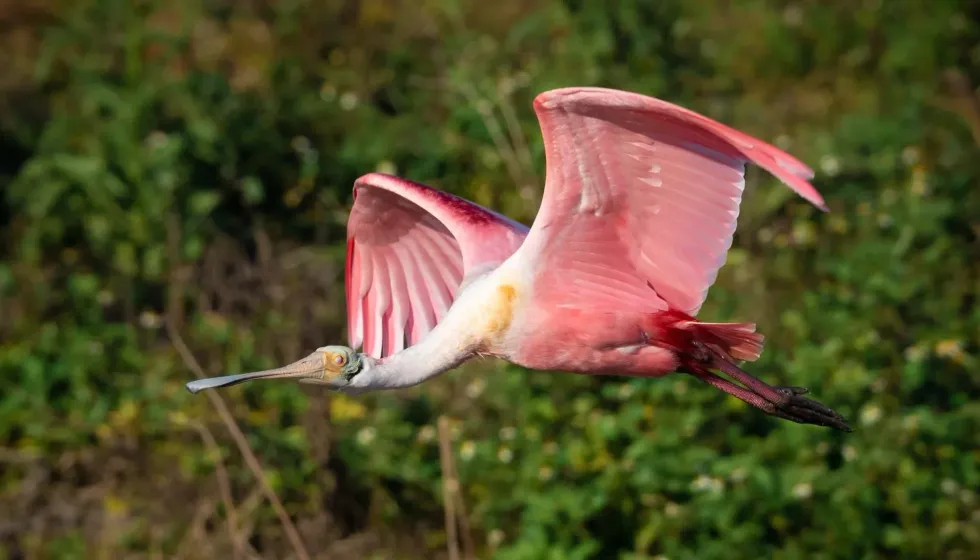A genus of birds called Platalea of the family Threskiornithidae, spoonbills are wading birds found all over the world. They live in wetlands, estuaries, and lakes and can live in both saltwater and freshwater.
There are six different species of spoonbills which are the Eurasian spoonbill or European spoonbill (Platalea leucorodia), roseate spoonbill (Platalea ajaja), royal spoonbill (Platalea regia), yellow billed spoonbill (Platalea flavipes), and African spoonbill (Platalea alba).
Spoonbills are closely related to ibises and the main difference between these two birds is the shape of their bills. Spoonbill birds got their name because of their spoon shaped bills that are wider, longer, and flatter at the end than that of ibises.
Spoonbills hunt by foraging in the water and they sweep the bill from side to side in the water.
When prey like crabs, insects, shrimp or small fish touch the sides of the bill, spoonbills snap them up. These birds need to feed several times a day, so they can be seen foraging in the day and nighttime in the shallow waters of their habitat.
You may also check out the fact files on royal spoonbill and black faced spoonbill from Kidadl.
Spoonbill Interesting Facts
What type of animal is a spoonbill?
A spoonbill bird is a type of wading bird of the family Threskiornithidae.
What class of animal does a spoonbill belong to?
All species of spoonbills are birds, so their class is Aves.
How many spoonbills are there in the world?
One of the cool spoonbill bird facts is that there are six different species of spoonbills in the world. Five of these including roseate spoonbills are classified as Least Concern, so there is no record of their numbers as the populations are stable. In the USA, roseate spoonbills are found in Florida, Texas, and Louisiana.
The one Endangered species, black faced spoonbills (Platalea minor), there are only 2250 adults left in the world.
Where does a spoonbill live?
Spoonbills live in wetlands, estuaries, saltwater bayous, and lakes preferring shallow waters for feeding.
What is a spoonbill's habitat?
Spoonbills are spread across the world, wherever there is water. They are called wading birds, waders, or shorebirds because they live near water and forage for food along mudflats and banks of the water source. They prefer shallow water for foraging and feeding. Their nests are made in trees or reed beds close to their feeding areas.
Who do spoonbills live with?
Spoonbills live in nests with their families made up of a male, female, and their eggs. These nests are made in colonies along with other spoonbills and even other species of wading birds such as herons like the grey heron and ibises like the glossy ibis.
How long does a spoonbill live?
Different species of spoonbill have different lifespan ranges. For instance, the Eurasian spoonbill, also known as the European spoonbill (Platalea leucorodia), will live up to 30 years in captivity, and 25 years in the wild.
In contrast, the roseate spoonbill (Platalea ajaja) will live up to 15 years in captivity, and about 10 years in the wild in places like Florida, Texas, and Louisiana.
How do they reproduce?
Spoonbills have breeding seasons as all birds do. Mature spoonbills of some species develop new features like the yellow breeding plumage of the black faced spoonbill, or white plumes on the back of the heads of royal spoonbills. There is no sexual dimorphism among spoonbills, including roseate spoonbills. These birds are monogamous for the duration of the breeding season.
The males gather the material for the nest while the females construct it in an oval shape. Females lay anything between two to four eggs, and sometimes up to five eggs in their nests.
Young birds emerge from the eggs after about 21 days or so. The parents feed and care for their young until they are ready to fly out of the nest.
What is their conservation status?
The majority of the species of spoonbills including roseate spoonbills have the conservation status of Least Concern. Their populations are stable and abundant. Roseate spoonbills are easily found in coastal Florida and Texas.
However, the black faced spoonbill bird has the conservation status of Endangered. Human activities of development have led to the loss of habitat and these birds are also hunted for food. Efforts for conservation have resulted in an increase in their population since 2017. Currently, there are 2250 adults in the world.
Spoonbill Fun Facts
What do spoonbills look like?
Spoonbills have long, thin legs which may be white, pink, or black. They have been named for their distinctive spoon shaped bills which may be yellow, black, or pink, depending on the species.
Spoonbills typically have white or cream colored plumage. The roseate spoonbill (Platalea ajaja) is different in that it has vivid pink feathers.
How cute are they?
Spoonbills are fairly odd looking, so you might not find them very cute. They can look very beautiful especially the roseate spoonbill which is found in southern USA including Florida, Texas, and Louisiana!
How do they communicate?
As a species, spoonbills are fairly quiet. They communicate with each other and other birds using smells, body language, or chemicals. When they are mating, the males might make small grunting sounds at the females or even to other males to warn them off.
How big is a spoonbill?
Spoonbills have a length range between 24-32 in (60.96-81.28 cm). In contrast, least sandpipers have an average length range of 5.1-5.9 in (12.9-14.9 cm). This makes spoonbills about five times bigger than least sandpipers in length.
Similarly, the average height of spoonbills is around 48 in (121.92 cm). In contrast, least sandpipers have an average height of around 4.7 in (11.9 cm). This makes spoonbills almost 10 times bigger than least sandpipers in height!
How fast can a spoonbill move?
There has been no documentation of the speed at which spoonbills move. Some species are migratory, so they should be able to fly relatively quickly to reach their winter homes in time.
How much does a spoonbill weigh?
Depending on the species, the spoonbill bird can weigh anything between 2.2-4.1 lb (0.99-1.85 kg).
What are the male and female names of the species?
There are no special names for male or female spoonbills, regardless of species. Male birds are simply called males and female birds are called females.
What would you call a baby spoonbill?
Like babies of most birds, baby spoonbills are called chicks.
What do they eat?
Spoonbills wade into shallow waters of the lake or estuaries which is their habitat to hunt for small fish, crustaceans, snails, or insects. They eat most small fish that are ignored by other wading birds.
As most of their catch is quite small, these birds are found foraging for food in the shallow waters many times a day.
Are they dangerous?
Spoonbills tend not to interact with humans at all, so they are not dangerous to human beings.
Would they make a good pet?
A spoonbill bird will not make a good pet. It is a wild animal that needs to live in wetlands to source its food. It could be cared for in a zoo, but never in a private home.
Did you know...
The black faced spoonbill bird is recognized as a natural monument in South Korea.
The African spoonbill has pink legs, a pink face, and a pink beak, but no plumage on its head.
One of the interesting spoonbill facts is that they fly with their heads extended, unlike the herons.
What are the different types of spoonbill?
There are six different species of spoonbill bird. The most visually distinct is the roseate spoonbill which has pink feathers, unlike the white feathers of the other spoonbill species.
They also have yellow and green feathers on their heads. This species is only found in South America, southern United States, and the Caribbean. In the USA, they are found in coastal Florida, Texas, and southwest Louisiana.
The Endangered species among the spoonbills is the black faced spoonbill, named because of the black color of its face and beak. These birds are found in Asia in countries like Taiwan, China, Korea, and Japan, and are protected.
Black faced spoonbills are closely related to Eurasian spoonbills. This species has black bills, black legs, and black wingtips. They are found in Africa, Europe, and Asia.
African spoonbills have pink faces, bills, and pink legs. This bird is widespread in Madagascar and Africa. Royal spoonbills have black faces, bills and legs, but they are much larger. They are found in Australia, New Zealand, Indonesia and the Pacific Islands.
Yellow billed spoonbills are named for the color of their bills. They are also found in Australia.
Why are spoonbills pink?
Roseate spoonbills (Platalea ajaja) have vivid pink feathers. This is because of a pigment called canthaxanthin which is found in their diet, similar to how American flamingos get their color! Small flocks of these birds can be found in the USA in places like Florida, Texas and Louisiana.
Here at Kidadl, we have carefully created lots of interesting family friendly animal facts for everyone to discover! Learn more about some other birds from our limpkin facts and jack snipe facts pages.
You can even occupy yourself at home by coloring in one of our free printable spoonbill coloring pages.









